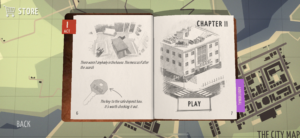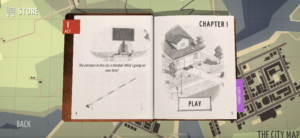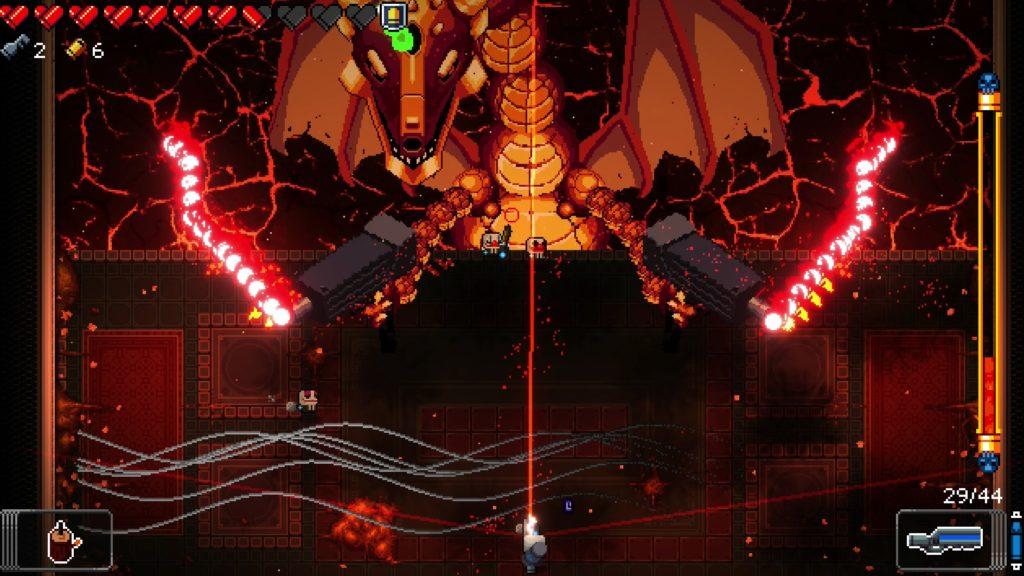The game I chose to play is Tiny Rooms: Story Mystery (TRSM), a mystery/adventure game developed by Kiary Games. TRSM is a mobile game that’s played individually. I played this game on my phone, which lessened the learning curve and made the experience feel more personal because I could easily tap and interact with the game. This game’s intended audience is casual players and those who enjoy mystery games! It’s recommended for those 12+ because players need to understand logic-based puzzles and layered mysteries.
In TRSM, players explore miniature rooms to solve mysteries. Each room contains interactive objects and hidden clues that must be discovered and used in a specific order to unlock new spaces and advance the story. TRSM successfully weaves narrative into the mystery using discovery through puzzle-solving as the main storytelling device. The architecture of each room acts as both the setting and the narrator, guiding players through a series of locked spaces that creates plot only when explored. Thus, the game’s structure lets mystery emerge entirely through interaction.
TRSM’s narrative depends entirely on player interaction, with the story unfolding only through active exploration of the game’s environment. Instead of creating plot through traditional narrative strategies like dialogue or cutscenes, TRSM requires players to engage directly with the space in order to uncover the mystery of the plot. Thus, the puzzles are more than a challenge, they are narrative devices. For example, as I was exploring drawers to find a key for a door, I instead found a gun. This gun wasn’t exactly a puzzle I needed to solve, but it was a result of a puzzle that would add more plot later on in the story. It was a narrative detail revealed through interaction, showing how even unintentional discoveries can deepen the mystery and build tension in a game. Whether it’s finding a key, rearranging objects, or unlocking a hidden door, every action moves the story forward. From a game design perspective, the puzzle-solving mechanics of the game directly sparks a dynamic of discovery, which ultimately creates an aesthetic of curiousity. Thus, exploration feel meaningful because the game only reveals its mystery when the player actively participates. This also reflects the formal element of procedure, where structured actions based on the games’ rules/systems (i.e. sequences of puzzles, only being able to open certain drawers, etc.) shape how players interact with the game and uncover its narrative. Rather than presenting the story upfront, TRSM lets players build it themselves through the choices they make and their discoveries.
Additionally, TRSM uses physical progression through space as a storytelling structure, making exploration not just a way to navigate the game, but the only way to uncover its emotional core. TRSM’s architecture fragments the narrative, turning each room into its own individual story piece that only gains deeper meaning when connected through spatial exploration. Each room acts as its own “chapter of a book,” offering a small glimpse into the story, but never the full picture. When I played the game, I was first met with the prompt: “I haven’t spoken to my father for more than 10 years. Why did he write to me now?” (pictured below). That question lingered as I moved through each room. After I solved the first room (the dad’s house), I found out that nobody was there and that I would have to go to the bank to unravel more of the story. Thus, each individual room adds to a larger story that develops only as you explore more rooms! This is an example of an embedded narrative, where the architecture controls not just the pacing but the broader story. The player must actively explore the space to assemble pieces of the plot, making the physical layout of the game essential to how the narrative is experienced. Moreover, the primary function of each room is to act as the constraint, but its secondary function is to encourage new discoveries to create new archs. I do believe that the developers could’ve made exploration of the game more intuitive. At times, the sheer number of doors and constantly needing to rotate rooms to reveal hidden walls made navigation feel overwhelming. This occasionally disrupted the flow of discovery.
Pictured below: Instances of the story evolving and how the game uses the embedded narrative architecture.



TRSM does include helpful features like a hint system and directional guidance to keep players from getting totally lost. If you start going off track, the game will tell you, which makes a huge difference in a puzzle-heavy environment where it’s easy to get lost. This feature helps reduce frustration and supports players who might struggle with mystery/puzzle games. However, while the hints make navigation more accessible, the game still has some accessibility challenges, especially around memory. The game sometimes saves what you’ve discovered, but not always, which makes it hard to track what you’ve already found or what’s still important. For players who struggle with memory, this can be frustrating. There’s no consistent way to revisit past clues or keep notes in the game, so remembering where a symbol was or which room had a certain item often relies on mental recall alone. The embedded narrative asks players to piece together scattered story elements, but without more built-in support for memory, that process becomes harder for some players than others. Even with strong directional tools, the sheer amount of material and information can be overwhelming, especially in a game where understanding the story depends on what you’ve seen and when.




cool game!